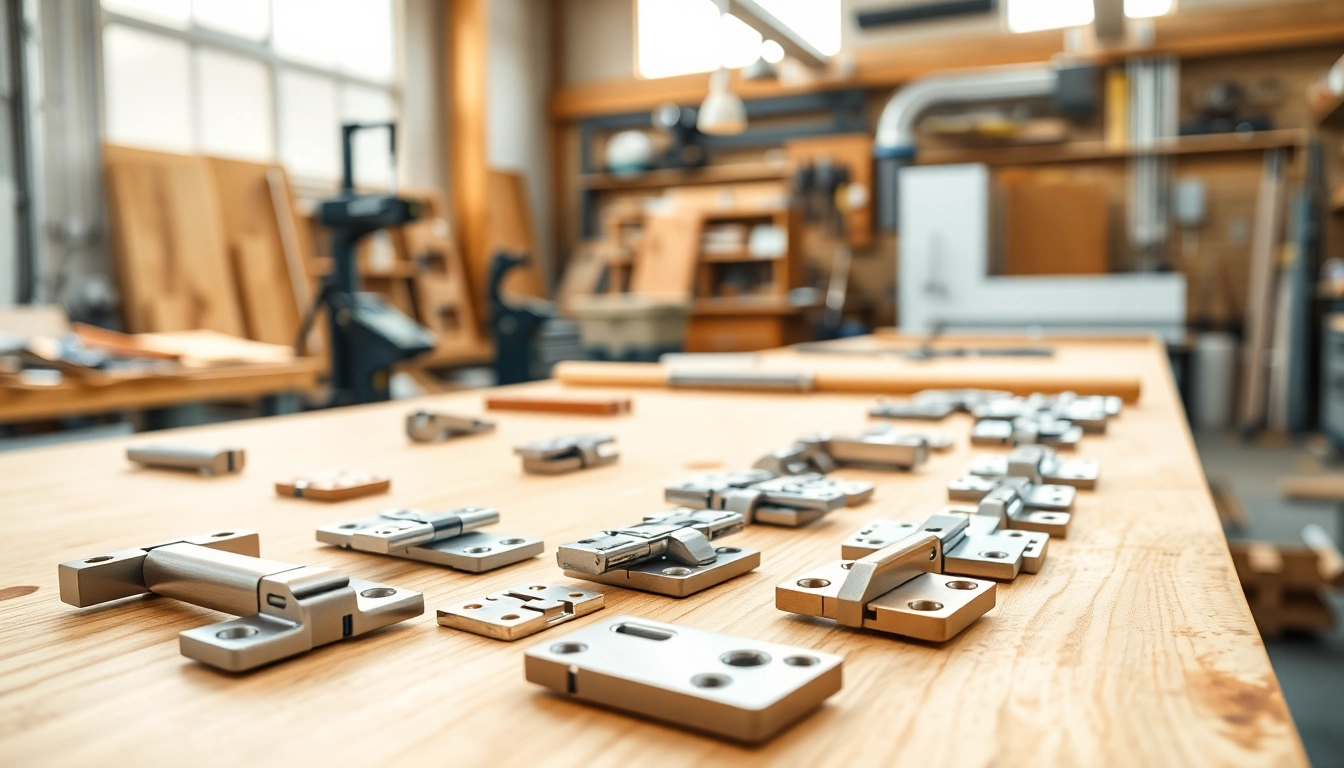Understanding Cabinet Hinges and Their Functionality
What Are Cabinet Hinges?
Cabinet hinges are crucial components in cabinetry, enabling smooth door openings and closures. They connect a cabinet door to its frame, allowing for full access to the contents within. The complexity of a hinge mechanism can vary, from simple pin-and-swing designs to more sophisticated concealed hinges that hide the hardware from view. These components are typically made from robust materials such as steel, brass, or stainless steel, ensuring durability and longevity.
The Importance of Quality in Cabinet Hinges
The quality of cabinet hinges can significantly affect not only the performance of the doors but also their lifespan. High-quality hinges reduce the risk of sagging doors and premature wear, ensuring that the cabinet functions smoothly over time. Faulty or low-grade hinges could lead to more severe issues, such as misalignment or even damaging the cabinet structure. Therefore, investing in reputable Cabinet Hinge Manufacturers is essential for ensuring reliability and quality.
Types of Cabinet Hinges Manufacturers Produce
Various types of cabinet hinges are available, each designed for specific applications. Common categories include:
- Concealed Hinges: Also known as European hinges, these are hidden from sight when the cabinet doors are closed and provide a clean, sleek appearance.
- Overlay Hinges: Used when the cabinet door overlays the cabinet frame, allowing for a more robust appearance.
- Inset Hinges: These hinges are used when doors sit flush with the frame, providing a traditional look.
- Mechanical Hinges: Suitable for heavier doors, these hinges have a specific function or operation, often found in commercial applications.
How to Choose the Right Hinge for Your Cabinet
Considerations When Selecting Cabinet Hinges
Choosing the right hinge involves several considerations:
- Weight Capacity: The hinge must support the weight of the cabinet door without sagging.
- Door Style: Different styles may require different hinge types for optimal performance.
- Material: Select materials that resist moisture and wear, particularly in kitchen and bathroom environments.
- Finishes: Ensure that the hinge finish matches or complements the cabinet aesthetic for cohesive design.
Evaluating Hinge Quality: What to Look For
When assessing hinge quality, some critical factors come into play:
- Construction Material: Look for hinges made from solid materials like stainless steel or brass instead of flimsy plastic.
- Weight Tolerance: Consider how much weight the hinge can handle comfortably without risking deterioration.
- Brand Reputation: Research manufacturers’ reputations, focusing on customer feedback regarding longevity and usability.
- Rust Resistance: For areas with high humidity, such as kitchens, opt for rust-resistant finishes.
Common Mistakes in Choosing Cabinet Hinges
Many homeowners and contractors make mistakes when selecting cabinet hinges, such as:
- Ignoring Weight Limits: Not considering the weight capacity can lead to door sagging.
- Mismatch of Styles: Incompatible styles of hinges can detract from the overall aesthetics of the cabinetry.
- Overlooking Functionality: Choosing a decorative hinge when a sturdier, functional one is required.
The Role of Technology in Hinge Manufacturing
Innovative Techniques Used by Cabinet Hinge Manufacturers
Technological advancements have transformed hinge manufacturing, leading to innovative techniques that result in stronger, more efficient hinges. Manufacturers now leverage tools such as:
- CAD Software: Enables precise designs and simulations, ensuring a good fit and function.
- Advanced Material Engineering: Utilizes newer materials that provide enhanced durability and weight capacity.
- Robotic Assembly: Increases consistency and quality control in production.
How Technology Enhances Hinge Performance
Technology significantly improves hinge performance through:
- Soft-Close Mechanisms: Recent developments allow hinges to gently close without slamming, promoting quieter usage.
- Self-Closing Features: These features can ensure doors close securely without needing manual effort.
- Adjustable Designs: Allow for minor adjustments post-installation, which is particularly useful in compensating for settling or warping over time.
Upcoming Trends in Hinge Technology
As technology continues to evolve, several trends in hinge manufacturing are emerging:
- Sustainability: Eco-friendly materials and processes are increasingly being adopted in hinge production.
- Smart Hinges: The integration of technology enabling features like remote control operation for cabinets.
- Customizable Solutions: As customer preferences evolve, manufacturers are providing more customizable hinge options tailored to individual needs.
Top Cabinet Hinge Manufacturers: A Comparative Overview
Leading Brands in the Market
The cabinet hinge market is crowded with several reputable manufacturers known for their quality products. Some of the leading brands include:
- Blum: Renowned for their innovative designs, particularly in soft-close hinges.
- Amerock: Offers a wide range of styles that cater to various aesthetic preferences.
- Grass: Known for high-quality concealed hinges, suitable for modern cabinetry.
- Sugatsune: Famed for their unique and often bespoke hinge designs.
Manufacturer Comparisons: Quality vs. Cost
When comparing manufacturers, it’s vital to evaluate the balance between quality and cost. Some brands are more affordable but compromise on materials or features. It is essential to consider:
- Long-Term Costs: Cheaper hinges might save upfront costs, but they can lead to expenses in repairs or replacements.
- Feature Set: High-quality hinges often incorporate advanced technology, providing greater value over time.
- Warranty and Service: Reputable brands often back their products with warranties that can provide peace of mind.
Customer Reviews and Feedback on Popular Brands
Customer feedback can offer invaluable insights into the performance of different hinge brands. Common points of praise or criticism include:
- Durability: Reviews often mention how well a hinge holds up under heavy usage.
- Ease of Installation: User-friendliness during the installation is frequently highlighted as a significant factor in satisfaction.
- Noise Levels: Customers appreciate hinges that operate quietly, especially in residential settings.
Installation and Maintenance of Cabinet Hinges
Step-by-Step Guide to Installing Cabinet Hinges
Proper installation of cabinet hinges is crucial for their functionality and longevity. Here’s a straightforward guide:
- Gather Tools: Collect necessary tools, including a drill, screwdriver, level, and measuring tape.
- Mark Placement: Use a pencil to mark where the hinges will be attached on both the cabinet door and frame.
- Drill Holes: Carefully drill pilot holes to avoid splitting the wood.
- Attach Hinges: Secure the hinges to the cabinet frame first, ensuring that they are level.
- Hang the Door: Attach the door to the cabinet using the hinges, adjusting as necessary for proper alignment.
Maintenance Tips for Longevity of Cabinet Hinges
To ensure your cabinet hinges last, regular maintenance is essential. Consider these tips:
- Periodic Cleaning: Dust and debris can accumulate, which can hinder the function of the hinge. Regularly wipe them clean.
- Lubrication: Use a suitable lubricant occasionally to maintain smooth operation and prevent squeaks.
- Inspect for Damage: Regularly check for signs of wear and tear, and replace hinges at the first sign of significant wear.
When to Replace Your Cabinet Hinges
There are clear signs that indicate it’s time to replace cabinet hinges, including:
- Difficulty Opening or Closing: If the doors are not operating smoothly, it may be time for replacement.
- Visible Wear: Inspect for cracks or corrosion, especially in areas with high humidity.
- Inconsistent Alignment: If the door appears misaligned and adjustments won’t fix it, consider changing the hinges.



